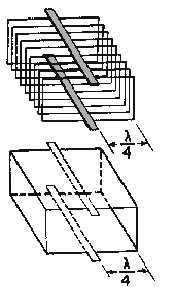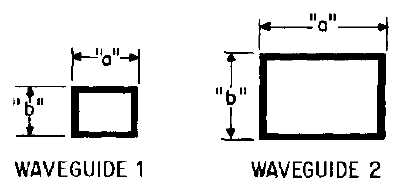1-7
Figure 1-8.—Forming a waveguide by adding quarter-wave sections.
The comparison of the way electromagnetic fields work on a transmission line and in a waveguide is
not exact. During the change from a two-wire line to a waveguide, the electromagnetic field
configurations also undergo many changes. These will be discussed later in this chapter. As a result of
these changes, the waveguide does not actually operate like a two-wire line that is completely shunted by
quarter-wave sections. If it did, the use of a waveguide would be limited to a single-frequency wavelength
that was four times the length of the quarter-wave sections. In fact, waves of this length cannot pass
efficiently through waveguides. Only a small range of frequencies of somewhat shorter wavelength
(higher frequency) can pass efficiently.
As shown in figure 1-9, the widest dimension of a waveguide is called the "a" dimension and
determines the range of operating frequencies. The narrowest dimension determines the power-handling
capability of the waveguide and is called the "b" dimension.
Figure 1-9.—Labeling waveguide dimensions.




